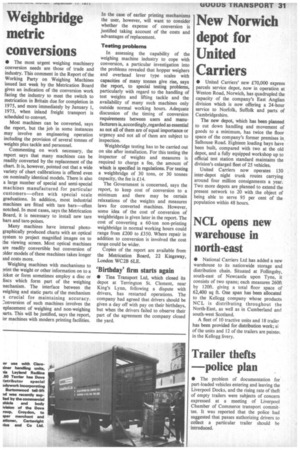Weighbridge metric conversions
Page 33

If you've noticed an error in this article please click here to report it so we can fix it.
• The most urgent weighing machinery conversion needs are those of trade and industry. This comment in the Report of the Working Party on Weighing Machines issued last week by the Metrication Board gives an indication of the conversion work facing the industry to meet the switch to metrication in Britain due for completion in 1975, and more immediately by January 1, 1973, when inland freight transport is scheduled to convert.
Most machines can be converted, says the report, but the job in some instances may involve an engineering operation including the provision of several tonnes of weights plus tackle and personnel.
Commenting on work necessary, the report says that many machines can be readily converted by the replacement of the chart. It is, however, pointed out that a wide variety of chart calibrations is offered even on nominally identical models. There is also a large number of special and semi-special machines manufactured for particular customers—often with special scale graduations. In addition, most industrial machines are fitted with tare bars—often notched. In most cases, says the Metrication Board, it is necessary to install new tare bars and tare-poises.
Many machines have internal photographically produced charts with an optical system to project magnified images on to the viewing screen. Most optical machines are readily convertible but conversion of plder models of these machines takes longer ind costs more.
Weighing machines with mechanisms to )rint the weight or other information on to a icket or form sometimes employ a disc or iiscs which form part of the weighing nechanism. The interface between the weighing and static parts of the mechanism s crucial for maintaining accuracy. :onversion of such machines involves the eplacement of weighing and non-weighing iarts. This will be justified, says the report, or machines with modern printing facilities. In the case of earlier printing mechanisms the user, however, will want to consider whether the expense of conversion is justified taking account of the costs and advantages of replacement.
Testing problems In assessing the capability of the weighing machine industry to cope with conversion, a particular investigation into the problems revealed that hopper weighers and overhead lever type scales with capacities of many tonnes give rise, says the report, to special testing problems, particularly with regard to the handling of test weights and lifting tackle and the availability of many such machines only outside normal working hours. Adequate discussion of the timing of conversion requirements between users and manufacturers is, accordingly, reg arded as essential as not all of them are of equal importance or urgency and not all of them are subject to inspection.
Weighbridge testing has to be carried out on site after installation. For this testing the inspector of weights and measures is required to charge a fee, the amount of which is specified in regulations. For testing a weighbridge of 30 tons, or 30 tonnes capacity, the fee is £14.
The Government is concerned, says the report, to keep cost of conversion to a minimum and there may be certain relaxations of the weights and measures laws for converted machines. However, some idea of the cost of conversion of weighbridges is given later in the report. The cost of converting a 60-ton non-printing weighbridge in normal working hours could range from £200 to £350. Where repair in addition to conversion is involved the cost range could be wider.
Copies of the report are available from the Metrication Board, 22 Kingsway, London WC2B 6LE.
'Birthday' firm starts again
• Tina Transport Ltd, which closed its depot at Terrington St. Clement, near King's Lynn, following a dispute with drivers, has restarted operations. The company had agreed that drivers should be given a day off with pay on their birthdays, but when the drivers failed to observe their part of the agreement the company closed the yard.




















































































































